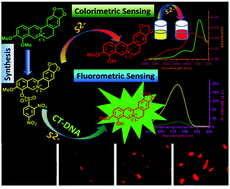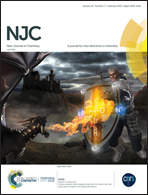Superb-selective chemodosimetric signaling of sulfide in the absence and in the presence of CT-DNA and imaging in living cells by a plant alkaloid berberine analogue†
Abstract
The present manuscript reports a lucrative design of a colorimetric and ratiometric chemodosimeter, 9-O-(2,4-dinitrobenzenesulfonyl)berberrubine (BER-S), with excellent water solubility for the superb selective detection of sulfides through a color alteration from yellow to red with a good limit of detection (LOD) of 56 nM in CP buffer solution (10 mM, pH 7.2). Interestingly, this work also includes a smart “turn-on” emission probe (BER-S/DNA complex) showing good linearity with an excellent LOD of 46 nM for recognizing sulfide anions. The probes, BER-S, and BER-S/DNA complex, displayed no interfering effect by other analytes or sulfur-containing inorganic compounds, like thiols. Characterization was carried out using IR, HRMS, and DFT for the BER-S probe, and time-resolved fluorescence lifetime measurement and fluorescence titration for the BER-S/DNA complex probe for elucidating their sensing mechanism. The detection of S2− in waste, tap, and drinking water by BER-S indicated its potential application in real sample analysis, while concentration variant cell imaging experiments (naked-eye red fluorescence) verified its cell-membrane permeability and capability for S2− imaging in living cells. This reaction-based sensing strategy in the presence of DNA may provide a potential platform for the design of a fluorescent chemodosimeter for extensive anion targets.



 Please wait while we load your content...
Please wait while we load your content...